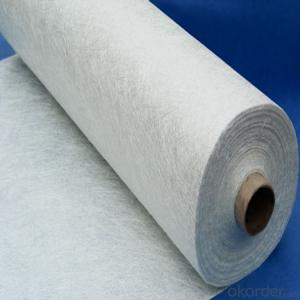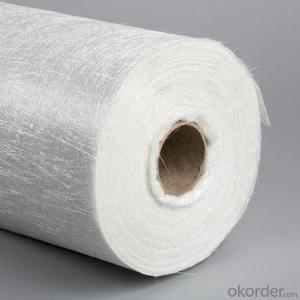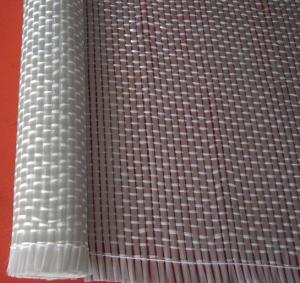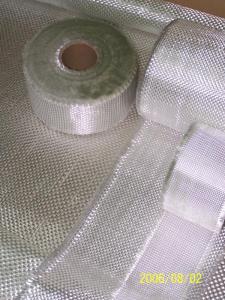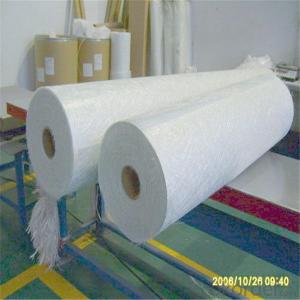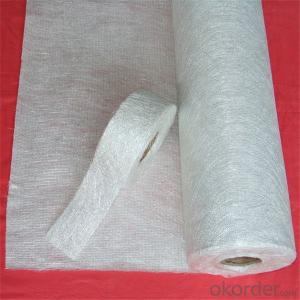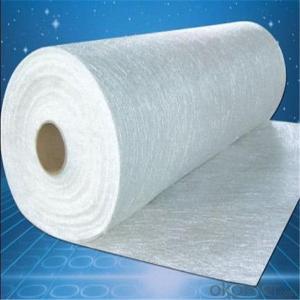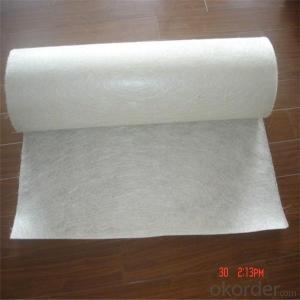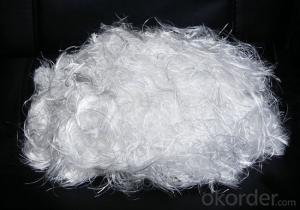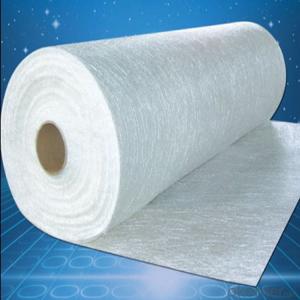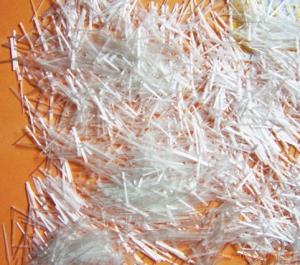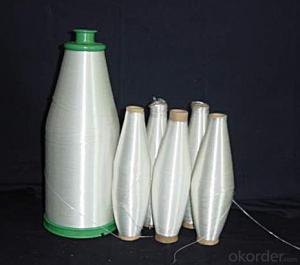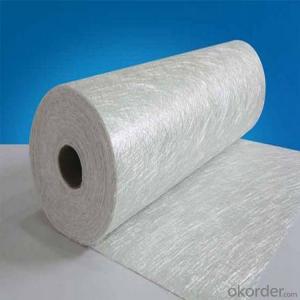300 g/m2 FiberGlass Chopped Strand Mat
- Loading Port:
- China main port
- Payment Terms:
- TT OR LC
- Min Order Qty:
- 1 kg
- Supply Capability:
- 5000 kg/month
OKorder Service Pledge
OKorder Financial Service
You Might Also Like
Product Description:
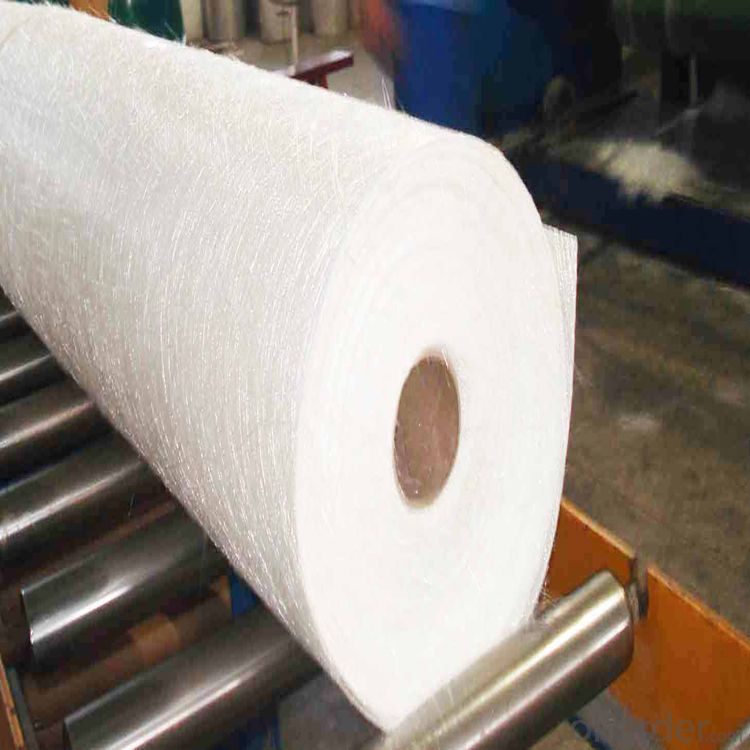
Surfacing Tissue mainly used in the surface layers of FRP products. It features even Fiber distribution, soft feel, level and smooth fiber surface, less glue content, quick resin soak and good pattern fitness. It can improve the product surface property on corrosion resistance, compressive strength, seepage resistance, and longer service life. It is also suitable for spraying; pattern pressing and other FRP pattern technology.
Surfacing Tissue mainly used in the surface layers of FRP products. It features even Fiber distribution, soft feel, level and smooth fiber surface, less glue content, quick resin soak and good pattern fitness. It can improve the product surface property on corrosion resistance, compressive strength, seepage resistance, and longer service life. It is also suitable for spraying; pattern pressing and other FRP pattern technology.
Product Features:
Fast breakdown in styrene
Fiber dispersed evenly
Low binder content
Superior acid corrosion resistance
Specifications:
Item | Over Density | Moisture Content | Chop Density | Polyester Yarn | Width |
(g/m2) | (%) | (g/m2) | (g/m2) | (mm) | |
EMK300 | 309.5 | ≤0.15 | 300 | 9.5 | 50-3300 |
EMK380 | 399 | 380 | 19 | ||
EMK450 | 459.5 | 450 | 9.5 | ||
EMK450 | 469 | 450 | 19 | ||
EMC0020 | 620.9 | 601.9 | 19 | ||
EMC0030 | 909.5 | 900 | 9.5 |
Product Packaging:
Each Surface Tissue is wound onto a paper tube which has an inside diameter of 76mm and the mat roll has a diameter of 330mm. The mat roll is wrapped up with plastic film,and then packed in a cardboard box or wrapped up with kraft paper. The rolls can be vertically or horizontally placed. For transportation, the rolls can be loaded into a cantainer directly or on pallets.
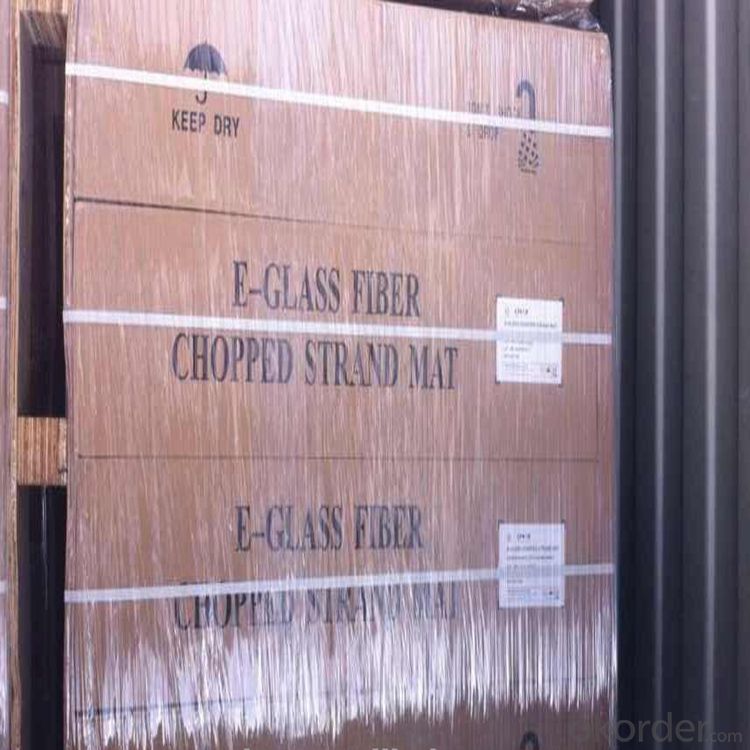
Product Storage:
Unless otherwise specified, Chopped Strand Mat should be stored in a dry, cool and rain-proof area. It is recommended that the room temperature and humidity should be always maintained at 15℃~35℃ and 50%~75% respectively.
Company Information
CNBM (China National Building Material) Group is the largest comprehensive building materials group in China that in integrate scientific research, manufacturing and logistics into one entity. The largest building materials and equipment specialists in China. Upon State Council approval, today CNBM owned more than 300 subordinate manufacturing factories and servicing companies. There are 6 fully owned public listed companies and 11 partially owned with substantial shares public listed companies. In many of these fields, CNBM is playing the leading role in the building industry in the country.

- Q:What are the disadvantages of using fiberglass chopped strand?
- Using fiberglass chopped strand comes with several disadvantages. To begin with, its tensile strength is lower compared to materials like carbon fiber, making it less effective in providing structural support in certain applications. Moreover, fiberglass chopped strand is prone to fraying and splitting, making it challenging to handle and work with. Additional steps, such as sealing the ends, may be necessary to prevent further damage. Furthermore, it is not as resistant to heat as other materials. High temperatures can result in degradation and loss of its properties, limiting its use in applications where heat resistance is crucial. In addition, fiberglass chopped strand exhibits poor resistance to chemicals and solvents. Exposure to certain substances can easily damage or weaken it, restricting its usability in various industries. Lastly, it is not biodegradable and can be challenging to recycle. This raises environmental concerns, particularly when used in large quantities or disposed of improperly. In conclusion, despite its advantages of being lightweight and cost-effective, it is crucial to consider these disadvantages before selecting fiberglass chopped strand as a reinforcement material.
- Q:Can fiberglass chopped strand be used in the production of medical prosthetics?
- Yes, fiberglass chopped strand can be used in the production of medical prosthetics. Fiberglass chopped strand is a reinforcing material that is typically made from fine glass fibers and is commonly used in composite materials. In the production of medical prosthetics, fiberglass chopped strand can be incorporated into the composite structure of the prosthetic limb or device to provide added strength and durability. It can enhance the structural integrity of the prosthetic, making it more resistant to stress and wear. Additionally, fiberglass chopped strand can be easily molded and shaped to fit the specific design requirements of the prosthetic, allowing for greater customization and comfort for the patient. However, it is important to note that the use of fiberglass chopped strand in medical prosthetics should be done in accordance with the relevant regulations and standards to ensure the safety and effectiveness of the final product.
- Q:Does fiberglass chopped strand have any biodegradability?
- Fiberglass chopped strand lacks any biodegradability, indeed. It is essentially a reinforced plastic derived from delicate glass fibers. These fibers possess a remarkable resistance to decomposition through natural means and remain intact indefinitely. Consequently, fiberglass chopped strand is not subject to biodegradation and can endure within the environment for an extended duration.
- Q:Can fiberglass chopped strand be used in the production of automotive parts?
- Automotive parts can be produced using fiberglass chopped strand. This reinforcement material is created by chopping fiberglass strands into smaller pieces. Its high strength-to-weight ratio, durability, and cost-effectiveness make it a popular choice in the manufacturing of automotive parts. In the automotive industry, fiberglass chopped strand is commonly utilized in the production of various components like body panels, bumpers, hoods, fenders, and interior parts. It is often combined with resin to form composite materials that possess excellent strength and stiffness properties. The length and orientation of the chopped strand can be tailored to meet specific design requirements, enabling a wide range of applications in automotive manufacturing. Moreover, fiberglass chopped strand provides several advantages for the production of automotive parts. Firstly, it is lightweight, which aids in reducing the overall vehicle weight and enhancing fuel efficiency. Furthermore, it boasts remarkable corrosion resistance, making it suitable for automotive applications that are exposed to harsh environments. Additionally, fiberglass chopped strand exhibits good dimensional stability and can withstand high temperatures, making it suitable for under-the-hood components. In conclusion, fiberglass chopped strand is a versatile and dependable material that can be effectively employed in the production of automotive parts. Its unique properties make it an excellent choice for manufacturers seeking to enhance the performance, durability, and cost-effectiveness of their automotive components.
- Q:What is fiberglass chopped strand?
- Fiberglass chopped strand is made up of tiny strands of fiberglass that have been cut into short lengths, typically between 1/8 inch and 2 inches. These strands are created by drawing molten glass into fine filaments and then chopping them into small pieces. The resulting chopped strand is utilized as a reinforcement material in various industries, such as automotive, construction, and marine. It is often combined with other materials, like resins or plastics, to form composite materials that possess increased strength and durability. Fiberglass chopped strand boasts exceptional mechanical properties, including high tensile strength, lightweight, and resistance to corrosion and chemicals. It is extensively employed in applications such as insulation, reinforcing concrete, pipe and tank manufacturing, and the production of fiberglass-reinforced plastics. In sum, fiberglass chopped strand plays a vital role in enhancing the performance and lifespan of a wide range of products and materials.
- Q:How does the moisture content of fiberglass chopped strand affect its performance?
- The moisture content of fiberglass chopped strand can significantly impact its performance. Excess moisture can lead to reduced mechanical properties, such as decreased tensile strength and impact resistance. It can also cause delamination or blistering of the resin matrix, reducing the overall integrity of the composite material. Additionally, moisture can promote the growth of microorganisms, leading to degradation and potential failure over time. Therefore, it is essential to ensure proper moisture control and storage conditions for fiberglass chopped strand to maintain optimal performance.
- Q:Can fiberglass chopped strand be used in the production of wind turbine nacelles?
- Yes, fiberglass chopped strand can be used in the production of wind turbine nacelles.
- Q:How is fiberglass chopped strand tested for quality control?
- Fiberglass chopped strand is tested for quality control through various methods to ensure its performance and reliability. These testing procedures involve examining the physical and chemical properties of the material to verify its adherence to industry standards and customer requirements. One of the primary tests conducted on fiberglass chopped strand is the determination of its length. This is done by randomly selecting samples and measuring the average length of the fibers. The length plays a significant role in the strength and integrity of the final product, so it is crucial to ensure that it falls within the specified range. Another important aspect of quality control testing for fiberglass chopped strand is the assessment of its diameter. The diameter of the fibers is measured to ensure uniformity, as any inconsistency could affect the overall performance of the fiberglass. This test is typically performed using specialized equipment that accurately measures the diameter of individual fibers. In addition to length and diameter measurements, the tensile strength of the fiberglass chopped strand is also evaluated. Tensile strength testing involves subjecting the fibers to controlled stress until they break. This test helps determine the maximum load the fibers can withstand before failure, which is crucial in assessing their suitability for various applications. Furthermore, the quality control process involves examining the moisture content of the fiberglass chopped strand. Moisture content is a critical factor, as excessive moisture can lead to reduced performance and potential issues during processing. By measuring the moisture content, manufacturers can ensure that the fiberglass meets the required specifications. Chemical testing is another crucial aspect of quality control for fiberglass chopped strand. This involves analyzing the chemical composition of the material to verify its compliance with industry standards and regulations. It ensures that the fiberglass does not contain any harmful substances that could compromise its performance or pose health risks. Overall, quality control testing for fiberglass chopped strand involves a comprehensive evaluation of its physical and chemical properties. This ensures that the material meets the necessary standards, guaranteeing its reliability and suitability for various applications.
- Q:Can fiberglass chopped strand be used for sound insulation?
- Yes, fiberglass chopped strand can be used for sound insulation. The irregular fibers of fiberglass help to absorb sound waves, reducing noise transmission and improving acoustics in various applications.
- Q:How is the dimensional stability of fiberglass chopped strand maintained?
- The dimensional stability of fiberglass chopped strand is primarily maintained through the use of proper manufacturing techniques and specific additives. During the manufacturing process, the glass fibers are carefully aligned and distributed evenly throughout the composite material. This ensures that the fibers are evenly dispersed, minimizing any potential shrinkage or expansion that may occur. Furthermore, the use of specific additives, such as binders and sizing agents, also contributes to the dimensional stability of fiberglass chopped strand. These additives help to improve the adhesion between the glass fibers and the matrix material, creating a strong bond that reduces the risk of dimensional changes over time. Additionally, the proper curing and cooling processes further enhance the dimensional stability of fiberglass chopped strand. By applying controlled heat and pressure during the curing process, the composite material is able to set and solidify in a way that minimizes any potential distortions or changes in shape. Proper cooling techniques are also employed to ensure that the composite material retains its desired dimensions. Overall, a combination of manufacturing techniques, additives, and curing processes are employed to maintain the dimensional stability of fiberglass chopped strand. These measures help to ensure that the composite material remains structurally sound and retains its intended shape over time.
1. Manufacturer Overview |
|
|---|---|
| Location | |
| Year Established | |
| Annual Output Value | |
| Main Markets | |
| Company Certifications | |
2. Manufacturer Certificates |
|
|---|---|
| a) Certification Name | |
| Range | |
| Reference | |
| Validity Period | |
3. Manufacturer Capability |
|
|---|---|
| a)Trade Capacity | |
| Nearest Port | |
| Export Percentage | |
| No.of Employees in Trade Department | |
| Language Spoken: | |
| b)Factory Information | |
| Factory Size: | |
| No. of Production Lines | |
| Contract Manufacturing | |
| Product Price Range | |
Send your message to us
300 g/m2 FiberGlass Chopped Strand Mat
- Loading Port:
- China main port
- Payment Terms:
- TT OR LC
- Min Order Qty:
- 1 kg
- Supply Capability:
- 5000 kg/month
OKorder Service Pledge
OKorder Financial Service
Similar products
New products
Hot products
Hot Searches
Related keywords

